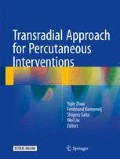Abstract
The less invasive radial access for percutaneous coronary intervention (PCI) has gained the favour of interventionists for its advantage in reducing access site complications, improving patient comfort and reducing mortality. However, due to the smaller diameters of radial artery, the catheter size is therefore too large for some patients, which makes this technique painful, cumbersome and sometimes unsafe, also sets a limitation for complex PCI. In addition, radial artery occlusion (RAO) is more common when guides are large in comparison to the radial artery. This led to the development of series of downsized equipment and corresponding techniques to overcome this problem, which was so called “Slender” for this new approach.
Access this chapter
Tax calculation will be finalised at checkout
Purchases are for personal use only
References
Chase AJ, Fretz EB, Warburton WP, et al. Association of the arterial access site at angioplasty with transfusion and mortality: the M.O.R.T.A.L study (Mortality benefit Of Reduced Transfusion after percutaneous coronary intervention via the Arm or Leg). Heart. 2008;94:1019–25.
Jolly SS, Yusuf S, Cairns J, et al. Radial versus femoral access for coronary angiography and intervention in patients with acute coronary syndromes (RIVAL): a randomised, parallel group, multicentre trial. Lancet. 2011;377:1409–20.
Hamon M, Pristipino C, Di Mario C, et al. Consensus document on the radial approach in percutaneous cardiovascular interventions: position paper by the European Association of Percutaneous Cardiovascular Interventions and Working Groups on Acute Cardiac Care** and Thrombosis of the European Society of Cardiology. EuroIntervention J EuroPCR Collaboration Working Group Interv Cardiol Eur Soc Cardiol. 2013;8:1242–51.
Rao SV, Tremmel JA, Gilchrist IC, et al. Best practices for transradial angiography and intervention: a consensus statement from the society for cardiovascular angiography and intervention’s transradial working group. Catheter Cardiovasc Interv Off J Soc Cardiac Angiography Interv. 2014;83:228–36.
Saito S, Ikei H, Hosokawa G, Tanaka S. Influence of the ratio between radial artery inner diameter and sheath outer diameter on radial artery flow after transradial coronary intervention. Catheter Cardiovasc Interv Off J Soc Cardiac Angiography Interv. 1999;46:173–8.
Kiemeneij F, Yoshimachi F, Matsukage T, et al. Focus on maximal miniaturisation of transradial coronary access materials and techniques by the Slender Club Japan and Europe: an overview and classification. EuroIntervention J EuroPCR Collaboration Working Group Interv Cardiol Eur Soc Cardiol. 2015;10:1178–86.
Amoroso G, van Dullemen A, Westgeest P, van Duinen M. “Virtual” 3 Fr transradial coronary stenting with the 5 Fr Meito Masamune sheathless guiding catheter: feasibility and safety in an outpatient setting. J Invasive Cardiol. 2016;28:109–14.
Tonomura D, Shimada Y, Yano K, et al. Feasibility and safety of a virtual 3-Fr sheathless-guiding system for percutaneous coronary intervention. Catheter Cardiovasc Interv Off J Soc Cardiac Angiography Interv. 2014;84:426–35.
Takeshita S, Asano H, Hata T, et al. Comparison of frequency of radial artery occlusion after 4Fr versus 6Fr transradial coronary intervention (from the Novel Angioplasty USIng Coronary Accessor Trial). Am J Cardiol. 2014;113:1986–9.
Hamood H, Makhoul N, Grenadir E, Kusniec F, Rosenschein U. Anchor wire technique improves device deliverability during PCI of CTOs and other complex subsets. Acute Card Care. 2006;8:139–42.
Fujita S, Tamai H, Kyo E, et al. New technique for superior guiding catheter support during advancement of a balloon in coronary angioplasty: the anchor technique. Catheter Cardiovasc Interv Off J Soc Cardiac Angiography Interv. 2003;59:482–8.
Takahashi S, Saito S, Tanaka S, et al. New method to increase a backup support of a 6 French guiding coronary catheter. Catheter Cardiovasc Interv Off J Soc Cardiac Angiography Interv. 2004;63:452–6.
Author information
Authors and Affiliations
Corresponding author
Editor information
Editors and Affiliations
1 Electronic Supplementary Material
Below is the link to the electronic supplementary material.
(WMV 17100 kb)
(WMV 33300 kb)
(WMV 14200 kb)
Rights and permissions
Copyright information
© 2017 Springer Science+Business Media Dordrecht
About this chapter
Cite this chapter
Kiemeneij, F., Saito, S., Liu, W. (2017). Slender PCI via Transradial Approach. In: Zhou, Y., Kiemeneij, F., Saito, S., Liu, W. (eds) Transradial Approach for Percutaneous Interventions. Springer, Dordrecht. https://doi.org/10.1007/978-94-017-7350-8_22
Download citation
DOI: https://doi.org/10.1007/978-94-017-7350-8_22
Published:
Publisher Name: Springer, Dordrecht
Print ISBN: 978-94-017-7349-2
Online ISBN: 978-94-017-7350-8
eBook Packages: MedicineMedicine (R0)

